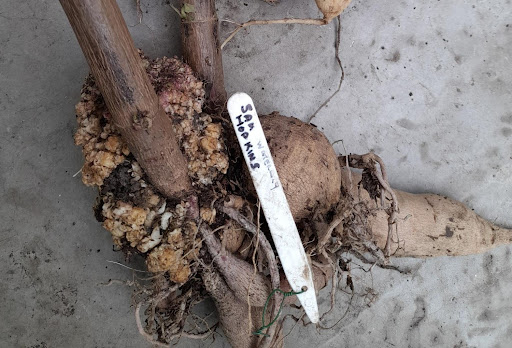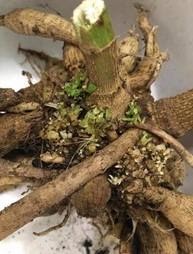One of the most frequent questions from members of the National Dahlia Society UK Facebook group and direct questions at shows and bureaux is the following . ‘What is Gall or what is leafy Gall’ This is an attempt to explain the difference. Having reviewed several papers on these subjects there appears to be agreement to the cause and the symptomatology but that is where the agreement ends, however there are common threads.
Crown Gall
The cause
Scientific name Bacterium Rhizobium radiobacter (synonym Agrobacterium tumefaciens) (1 and 2) The bacterium enters plants through wounds, either naturally made wounds or man-made such as grafting, planting or pruning. On entering the wound, a small piece of the bacterium’s DNA is transferred into the plant’s DNA. The bacterium’s DNA transforms normal plant cells in the wounded area into tumour cells. Once transformed, tumour cells proliferate automatically. The result is a gall: a disorganized mass.
Plants affected. Many plants in ninety families are susceptible and include
Herbaceous plants Alcea (hollyhock), Argyranthemum (marguerite), Begonia, Dahlia, Lathyrus (sweet pea), Lupinus (lupin) and Phlox
Vegetables Beetroot, courgettes, runner beans and swedes
Symptoms
Swellings (galls) on the plant stems or roots. In some cases, all the root systems may be replaced by massive, swollen tissues. Galls are usually rounded with a rough, irregular surface. They first appear as small protuberances on the plant surface. Galls on dahlia plant stems decay and soon disintegrate, but those on woody plants may be hard and perennial. Plant growth may be affected, but often there is little apparent damage and root galls may go unnoticed for lengthy periods or until lifting of tubers.

Control/Common sense precautions
Use only symptom-free nursery stock. Inspect new plants; do not plant plants where gall is suspected.
Avoid wounding plants, especially at planting.
Disinfect cutting tools frequently.
Where a plant is found with Crown Gall most expert papers recommend disposal of the affected plant but not on a compost heap.
The RHS suggests: Grow crops of potatoes or other vegetables (except beetroot, which are also susceptible) over the next one or two years to help eliminate the bacteria from the soil, or grass the area over for one or more years.
In the UK there appears to be no chemical products to control Crown Gall.
Leafy Gall
Scientific name infection by Rhodococcus fascians (formerly Corynebacterium fascians) (3and 4)has a similar effect to that of crown gall, another bacterial disease. ) The bacterium enters plants through wounds, either naturally made wounds or man-made such as grafting, on planting or pruning. On entering the wound, a small piece of the bacterium’s DNA is transferred into the host’s DNA. The bacterium’s DNA transforms normal plant cells in the wounded area into host tissues that produce dense clusters of distorted, stunted shoots at ground level.

Plants affected. This disease is seldom damaging. In the garden, Chrysanthemum, sweet peas, geranium, and dahlia are commonly affected.
Chemical Control
As far as can be found there are no chemical controls or treatment for leafy gall.
Control/common sense precautions
Use only symptom-free nursery stock. Inspect new plants; do not plant plants where gall is suspected. Immediately remove and destroy any diseased plants plus any neighbouring plants or trays. Plants can be infected with Leafy Gall for a number of weeks prior to symptoms development, so even though the plants may look healthy, they could be infected. Play on the safe side and toss them out. Regularly clean up and discard all old leaves and other plant debris. Soil can harbour both Crown and Leafy Gall.
Avoid wounding plants, especially at planting.
Disinfect cutting tools frequently and always between plants
Where a plant is found with Crown or Leafy Gall most expert papers recommend disposal of the affected plant but not on a compost heap.
References
- RHS Gardening Crown Gall
- Oregon State University Plant Diagnostic Handbook
- RHS Gardening Leafy Gall
- Oregon State University Plant Diagnostic Handbook
